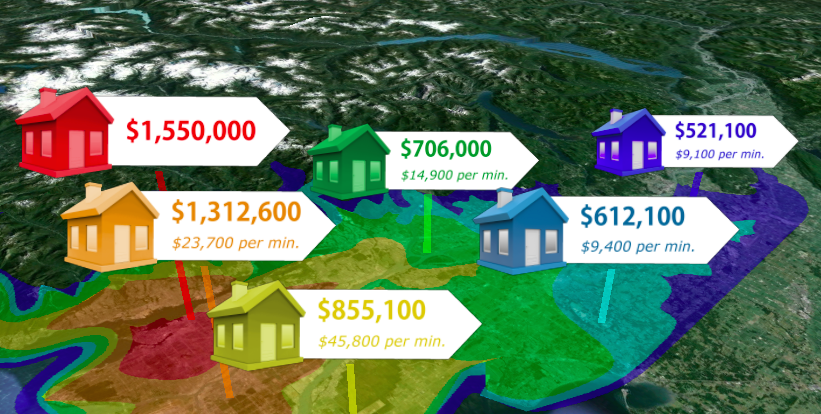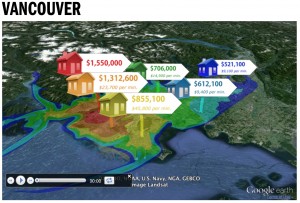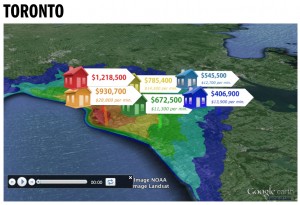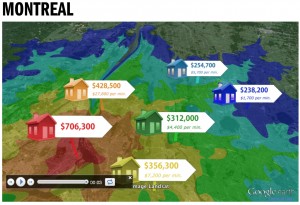When it comes to house prices, here’s how much location matters
A single minute of driving from downtown can save homebuyers thousands on the price of a house
Share


(Click on the image to the right to explore interactive maps showing how house prices change for each minute you drive away from downtown in Vancouver, Calgary, Toronto and Montreal. Note: The Google Earth plugin requires that users be on a laptop or desktop computer to view these maps.
Real estate agents have long touted location when buying a home, but the question of what, exactly, constitutes a great place to live has changed remarkably over the years. Where once the spacious calm of suburbia was preferable to cramped, noisy, inner-city neighbourhoods, these days, homebuyers are opting to stick close to revitalized downtown cores, near public transit, work, shops and entertainment.
That is, if they can afford it. An intriguing aspect of today’s preference for urban living is that many families still cling to suburban lifestyles, according to a recent study by Carleton University and University of Waterloo researchers. That includes a preference for single-family detached houses, not to mention the parking spots that usually accompany them. And that means there’s a huge premium on downtown homes, but also that those homebuyers willing to go the distance can save themselves big money.
For a full-screen version of this chart, click here.
To get a better idea of how big the downtown premium is, Brookfield RPS crunched the data for Maclean’s, looking at how much prices for a detached home decline the farther you get from downtown. Brookfield divided Canada’s four largest cities—Toronto, Montreal, Vancouver and Calgary—into six zones radiating outward from city hall, each reflecting 10 minutes of driving time in normal traffic conditions (although anyone who has tried commuting in Toronto or Vancouver during rush hour knows that 20 or 30 minutes behind the wheel doesn’t take you very far—yet another reason for staying downtown). With just one exception, prices dropped steadily the farther you get from each city’s central business district, although the rate of depreciation varies widely.
For a full-screen version of this chart, click here.
In Vancouver, where average prices within a 10-minute drive of downtown top the list at $1.5 million, real estate values fall by an average of $20,600 per minute, as one speeds over a bridge or two into surrounding communities. Buying near Toronto’s downtown core is almost as expensive, about $1.2 million on average, but the drop-off in home values is less precipitous as the CN Tower fades in the rear-view mirror—about $16,200 per minute. One reason for the difference: Vancouver is hemmed in by ocean and mountains, meaning there’s less land to build on. Montreal, meanwhile, shows a similar pattern of depreciation, but house prices are less expensive overall, and there’s less money to be saved by living farther away from the core.
Which brings us to Calgary. A fast-growing business centre, with soaring home prices to match, it’s the one big city in Canada where it’s often more desirable to live farther away from downtown than close to it. While the most expensive housing can still be found within 10 minutes of city hall, where average homes cost $665,000, prices fall to an average $515,000 once you’re 20 minutes out. Then, 40 minutes away, average prices creep back up again to $569,000.
Mary-Ann Mears, the managing broker of Sotheby’s International Realty Canada, says the unique phenomenon can be attributed to Calgary’s wealthiest homebuyers, who skew the data. That’s because, unlike other cities, they are just as likely to live out in the country, with its sprawling acreages and picturesque views, as they are close to the downtown office towers where they work. “They work all day and they want to have a horse, so land is important to them,” she says. And, thanks to a decent highway system and a huge swath of land that’s within an hour’s drive from downtown—about 3,544 sq. km compared to just 801 sq. km in Vancouver—even time-starved oil-patch execs find it relatively easy to escape the city limits at the end of the workday. “One of the draws of Calgary,” Mears says, “is people realize what a 30-minute commute can actually get them.”
(Click on the image to the right to explore interactive maps showing how house prices change for each minute you drive away from downtown in Vancouver, Calgary, Toronto and Montreal.)
THE MAPS
How to use and read these maps
Before using these interactive maps below, you’ll need to have the Google Earth plug-in installed. You can download it here). The plugin integration requires that users be on a desktop or laptop computer to view.
Press play on each map for a brief animation. Afterwards, use your keyboard to explore. To move up/down/left/right use the arrow keys. To rotate and tilt, hold down the shift key while using the arrow keys. To zoom in and out, use the – and + keys.
Each colour zone on the maps represents the distance a car could travel in 10 minutes (under normal driving conditions) away from downtown. The icons show the average price for a detached house in the corresponding zone, while the second number is the average price change per minute in that zone. Click to open each map in a new browser window. Google Earth maps created by Nick Taylor-Vaisey.



